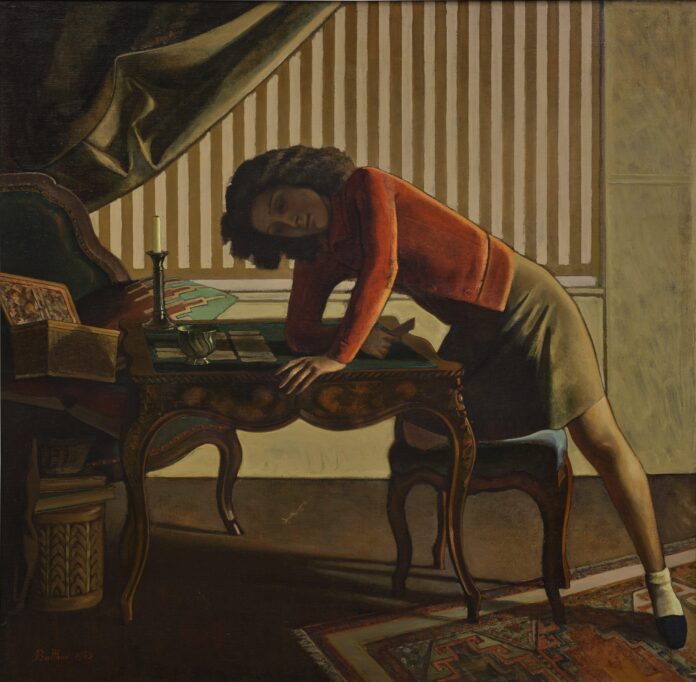A painting by the artist Balthasar Klossowski de Rola—better known as Balthus—that has been part of the collection of the Art Institute of Chicago (AIC) for almost six decades has been deaccessioned and will be offered at Sotheby’s New York this autumn. It is expected to fetch an eight figure-price, with the museum planning to use the funds for future acquisitions.
Balthus painted La Patience (1948) during the Second World War in Fribourg, Switzerland, beginning work on the painting in 1943 before revisiting it between 1946 and 1948. During this period of his career, Balthus often devoted extended time to refining his compositions, according to Sharon Kim, Sotheby’s deputy chairman for Modern art. The painting depicts his model Jeanette Aldry—older than many of his young models in Paris, Sotheby’s materials note—playing a game of solitaire, marking the first time Balthus explored card games in his work. The artist’s use of dramatic chiaroscuro lighting and reference to the passage of time with the inclusion of an extinguished candle in the painting nod to Old Master painters, according to Sotheby’s.
The auction house estimates the painting will fetch between $12m and $18m during its evening auction of Modern art in November. While Balthus’s work does appear at auction regularly, especially his works on paper, it’s rare for a painting of La Patience’s significance to come to market, Kim said in a statement.
For nearly 60 years, La Patience has been part of the AIC’s Joseph Winterbotham Collection, a group that contains up to 35 modern European paintings at any time. The collection was established in 1921 with a mandate “for continuous evaluation and improvement”, a museum spokesperson said in a statement. In order to acquire new work for this collection, the museum must deaccession from it. La Patience’s deaccession falls within the guidelines set by the Associated of Art Museum Directors (AAMD) because the funds will be used for acquisition.
La Patience was chosen for deaccession by curatorial staff from the Modern and Contemporary art and painting and sculpture of Europe departments at the AIC, which jointly oversee the collection. The fact that the museum’s collection now contains numerous works by Balthus, including two that are regularly on view, was one factor in the decision, the museum said. Girl with Cat (1937) is now the only significant painting by Balthus in the museum’s collection.
When the AIC acquired La Patience in 1964 directly from Balthus’s dealer Pierre Matisse (son of Henri) in New York, it was the only work by Balthus in the collection. The painting has not been on display in the galleries in nearly a decade, the museum’s spokesperson said, though it has been lent out extensively for exhibitions (the painting is currently on display at Sotheby’s showroom in Hong Kong).
“Deciding which art to part with is always a difficult decision, but this sale is in fulfillment of the ever-changing Winterbotham Collection’s spirit and guidelines,” a spokesperson said in a statement.
Other works from the Winterbotham Collection that were previously deaccessioned include Raoul Dufy’s The Open Window, Nice (1928) which fetched $564,500 (including fees) in 2021 and Paul Cézanne’s Houses on a River (1892-93), which sold for $11.1m (including fees) in 2018, both at Sotheby’s New York. The museum said the process has allowed for the acquisition of some of the most recognisable works in the AIC’s collection, including René Magritte’s Time Transfixed (1938) and an 1887 self-portrait by Vincent Van Gogh.
Balthus’s work has come under fire for his suggestive depictions of pubescent girls. In 2014, the Metropolitan Museum of Art in New York refused to take down a painting by Balthus called Thérèse Dreaming (1938) after thousands signed an online petition that claimed the Met was “supporting voyeurism and the objectification of children” by displaying the work with no clarification or caption acknowledging the controversy over Balthus’s subject matter. In 2014, the Museum Folkwang in Essen, Germany called off an exhibition of the artist’s work, saying that the display of Balthus’s photographs of a nude child may have resulted in “legal consequences”.
Despite the controversy, Balthus’s market remains strong.
“While Balthus, like many other artists, continues to be a topic of discussion for critics, curators and the general public alike, the top three most valuable works by the artist have all sold at auction within the last three years—each selling for more than $10 million—and thus indicating collector demand remains high for the artist,” Kim said in a statement.

























